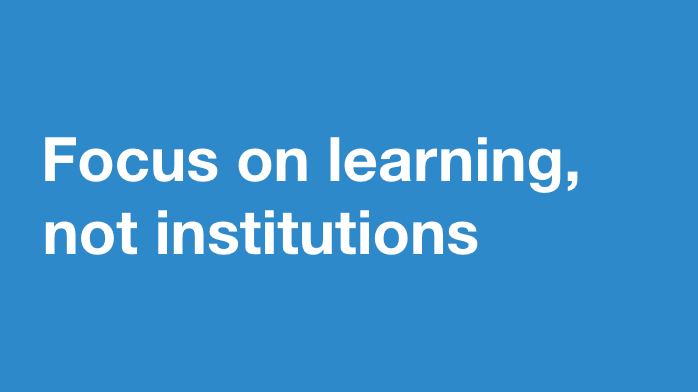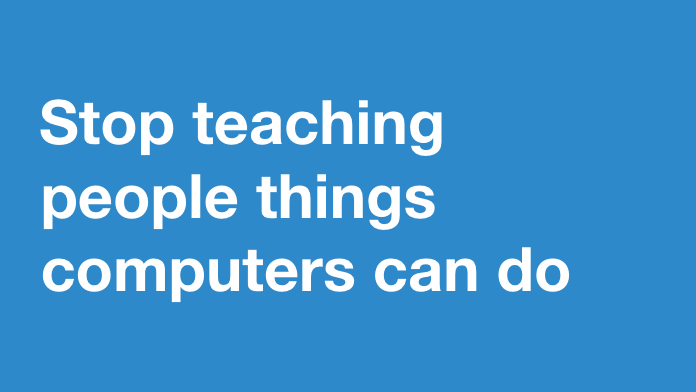Resources Index
-
An introduction to branding and marketing from Make It Clear
Branding and marketing your idea, where to begin?
When creating a business or launching a new product, one of the first things to consider is branding and marketing.
– Branding is who you are and what you look like
– Marketing is how you increase people’s awareness of who you are and how you sell to your target audience.
Branding and marketing have to work together so your product looks and talks to its audience in the same way and sells well!
What is branding?
To begin creating your brand, you must first ask yourself and your team a few questions to understand what your brand is. The questions below are a great place to begin:
- Why did you create your product?
- What makes your product different?
- What do you want people to think of when they hear your product name?
- What feelings/reactions do you want people to have when they think about your product?
The typical parts of a brand are:
- The brand identity: This includes things like your logo, colours and how you use things like photography or illustrations
- Brand values: The things you really care about, take a look at the Make it Clear brand values on this video we created here
- Brand positioning: This shows why your product is different and better than the others
- The brand tone of voice: How you talk to the people that will buy your product
Your branding will establish what people will expect from your product. Knowing what you want to represent in your brand, can guide your marketing.
What is marketing?
Marketing refers to methods used to increase awareness of your product among your target audience, through messaging and visuals. Marketing can become complicated so start by focusing on the following:
– What you want to say and how you want to say it
– How you can reach the people who will want to buy your product
(For example, what social media platforms do your target audience use, or would it be better to just drop a leaflet through a door?)
Chicken or the egg, branding or marketing – which comes first?
Because branding is who you are, it must come first. Before creating your marketing messaging and visuals, you must first decide who your brand is so that you know what you are communicating.
Conclusion
When it comes to building a great brand and marketing plan, it’s all about creating something that works best for your unique product. Sometimes things may not go as planned but the important thing is to try new ideas. So be brave and good luck with branding and marketing your product for the Design Ventura competition!
-
Industry Insights: Understanding the Pitching Process
We sometimes fall in love with our own ideas. Once we spent a lot of time thinking, prototyping and developing, we can get attached to them, and that’s a good thing. It means we believe in the product we have created and the purpose it has.
However, we should always be able to step away and look at our ideas through a different lens. Because when the pitching process starts, it is not what you or your team think about the product. It’s how the audience you are pitching to will perceive it that counts. Remember, it’s the first time they are going see it.
Be honest to yourself. And also, be aware of the people in the audience. try to understand them if you can. What have they done in the past, how do they approach their work. They need to be engaged, even entertained, while you are pitching. How are you going to engage and entertain them with your pitch?
There’s a question I always ask to myself when I have to present something new: Can I explain this idea in ten words or less? It’s a tough one, but it allows me to focus on communicating the most important things, without getting lost in irrelevant details.
Here is an example of my own work, where I was challenged to find ways to help raise funds for a charity called “Pathway” that helps homeless people get personalised medical attention when they are treated in a London Hospital.


This is the idea we had, in ten words: Up-cycle former homeless clothes to show transformational impact of healthcare.
So, when pitching your idea, keep that in mind: what ten words describes your product? Your audience might not be aware of all the work you put behind it but if the idea is relevant and catches their attention it will come alive and grow in the real world. Focus on that.
-
Inspiring creativity at The Festival of Education
The Design Ventura team was delighted to take part in the 10th edition of The Festival of Education in June. Set in the grounds of Wellington College, the festival hosted educators, practitioners, politicians and business leaders, to share ideas to help improve education for all.
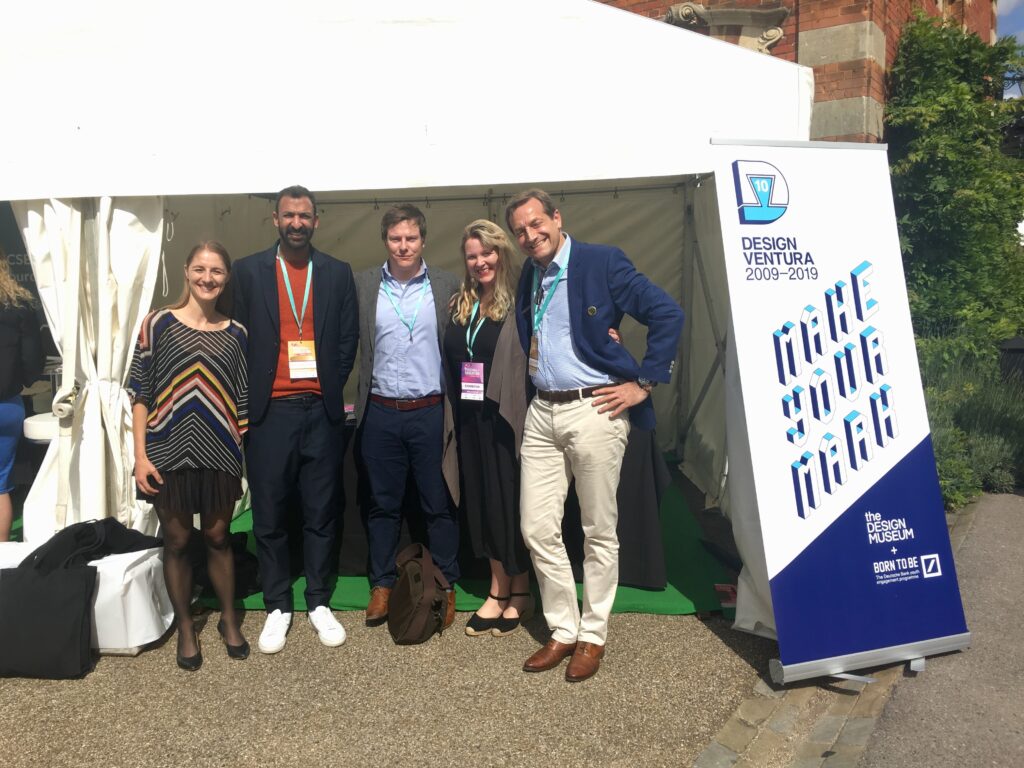
Our Design Ventura Stand and our guest speakers Design Ventura brought an array of design activities and events to the festival to help inspire teachers.
There was a Design Ventura stall, which provided a one-stop shop for information about the project and sold last year’s winning product Active Snap. There was also a Design Ventura exhibition of the past winning products in the V&A Cafe.
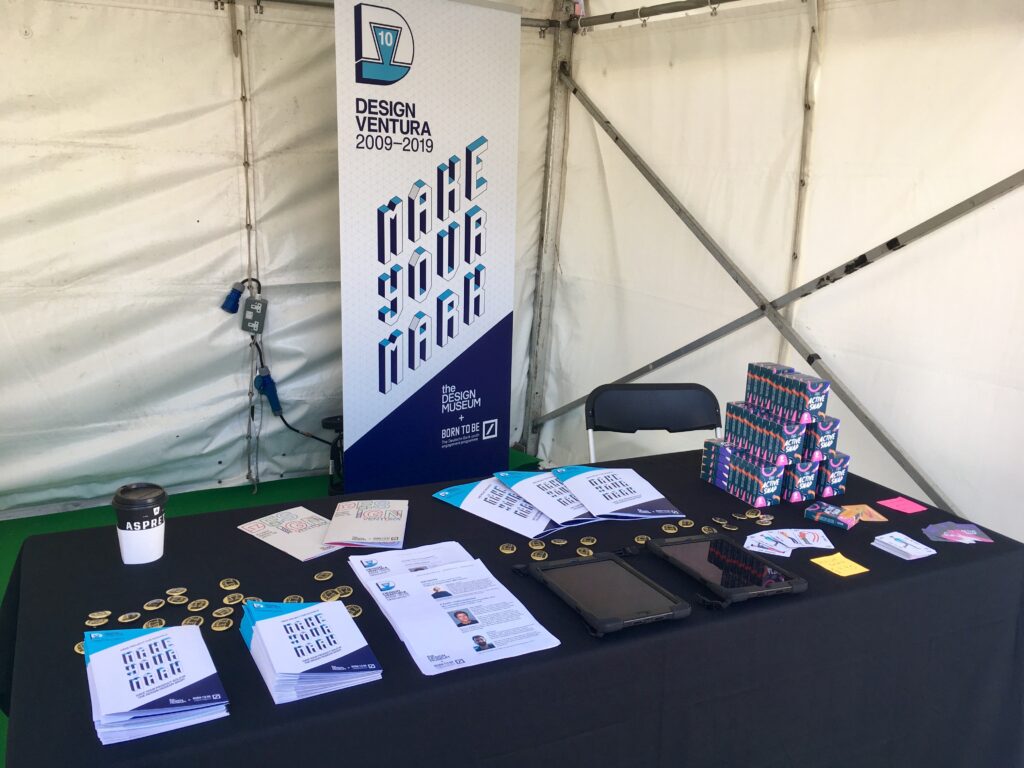
Design Ventura Exhibition at the V&A Cafe, Wellington College On top of this, Design Ventura curated a number of talks about design and creativity. We hosted a panel discussion on ‘Why we need creativity now more than ever‘ led by Sevra Davis, Head of Learning at the Design Museum. The panel included artist and designer Helga Schmid, Global Head of Marketing at Deutsche Bank, Christoph Woermann and London based architects Chris Hildrey and Asif Khan, who had a lively and engaging debate on the topic.
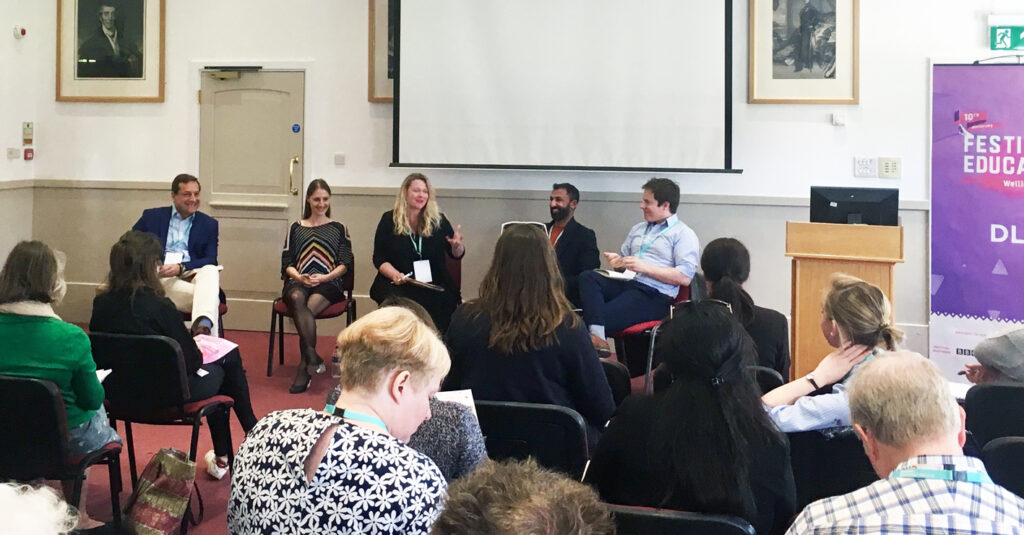
‘Why we need creativity now more than ever’ Panel Discussion Sebastian Conran delivered a fascinating keynote speech in the BBC Venue about his journey to becoming a designer, entitled ‘Design is not pretty, soft or fluffy‘.
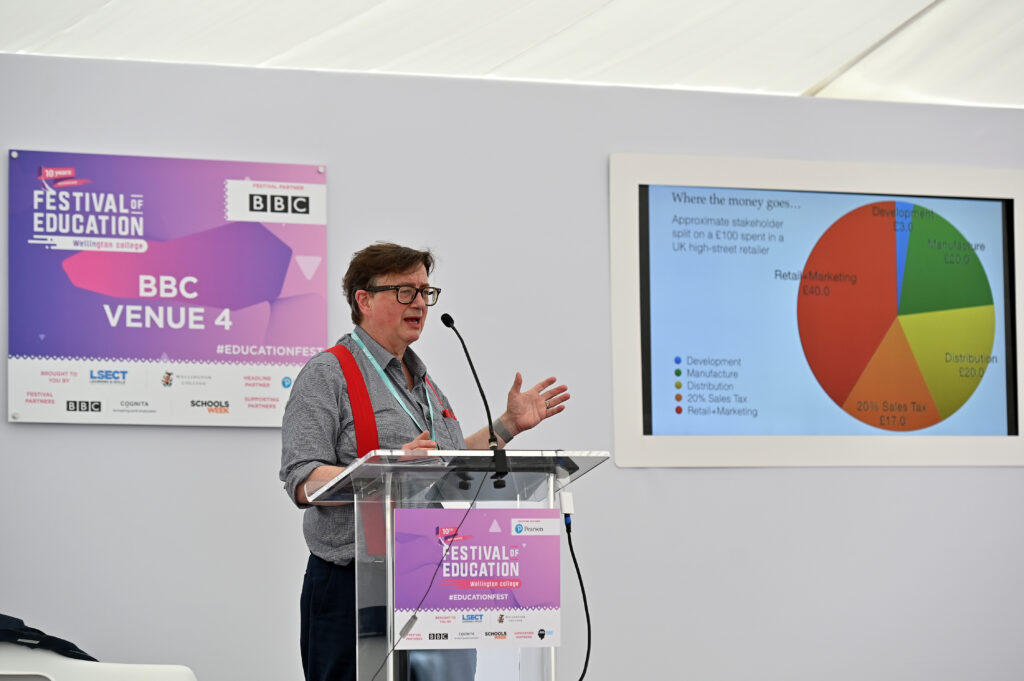
Day 2-Festival of Education at Wellington College, on Fri. 21 June 2019. Photo by Mark Allan This was all topped off by a Design CPD with Ellen Ferguson, who delivers the Teacher CPD events for Design Ventura. This hands-on workshop included object handling from the Design Museum’s handling collection.
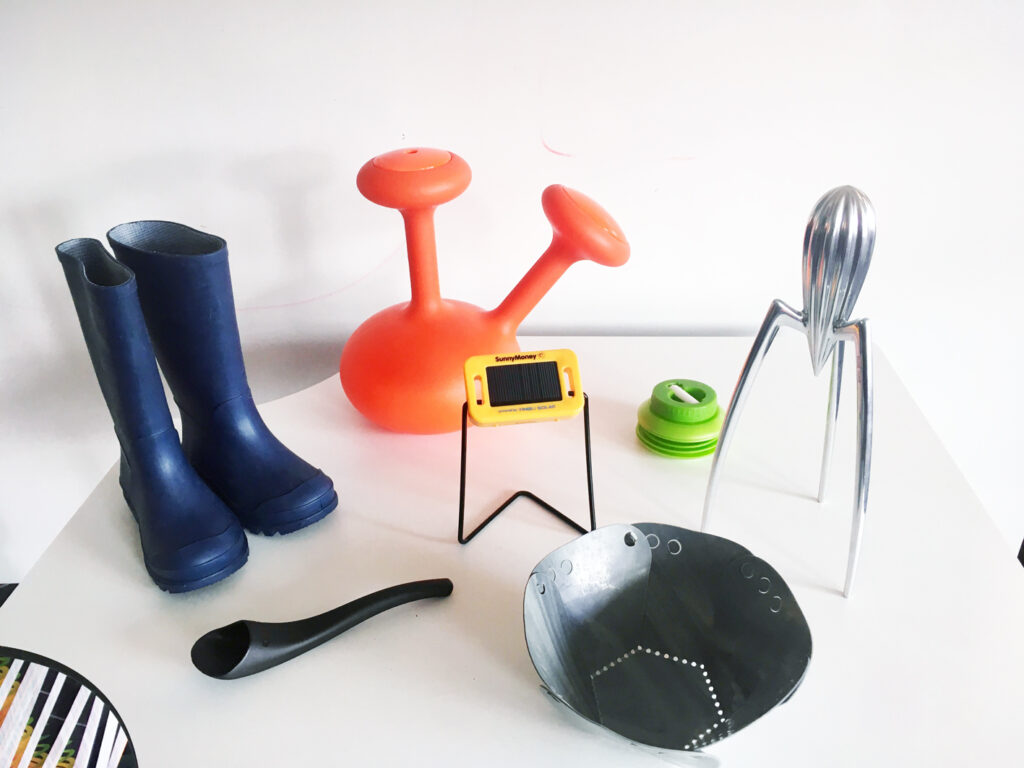
Handling Collection of Objects from the Design CPD Thank you to everyone who visited our stall and attended our talks and events as part of the Festival of Education, it was a very inspiring start to the summer!
-
Design Ventura Masterclass and Celebration Event 2017
Last week the Design Ventura team welcomed the top ten schools back in the Design Museum for a special day celebrating design.
The day started with a fun ice-breaker lead by Catherine Ritman-Smith, Director of Learning at the Design Museum, which was followed by two incredible presentations by the guest designers Heather Corcoran from Kickstarter and Herny James from Inventid.
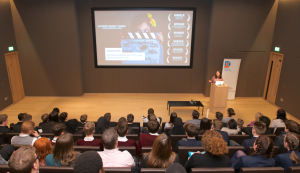
The afternoon started with a career insight speed dating activity which allowed students, teachers, family and friends to have the opportunity to ask experts from the industry about how their creative and enterprise skills have supported their successful transition into the workplace.
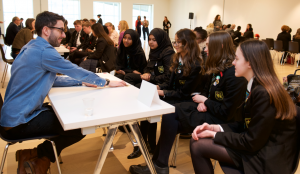
After tea and cake and while family and friends were visiting the galleries, the students activities continued. Students had a chance to participate in a fantastic drawing workshop lead by Peter Ayres from Beep Studio; and an exciting Little Bits workshop lead by Carlos Izsak from Makercart.
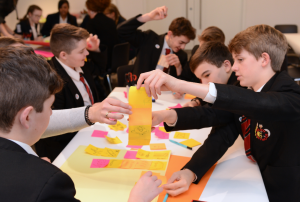
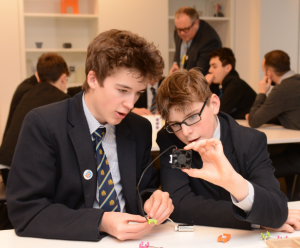
In the evening, the Design Museum opened its doors to the shortlisted school teams, their teachers, family and friends, Deutsche Bank employees, Design Industry Experts, the Design Museum team and special VIP guests to celebrate the success of Design Ventura 2017.
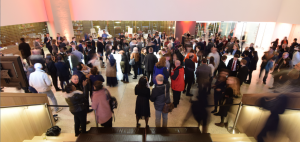
The event gave the students a chance to explain their innovative products to guests, network with people from the industry and be an advocates for their schools. Guest were really impressed with the confidence and communication skills that the students demonstrated.
Last year’s winners Harrogate Grammar School presented a cheque of £1080 from the proceeds of their product (Hook2O) to a representative of their chosen charity, The Sir Robert Ogden Macmillan Centre.
The anticipated announcement of the Design Ventura 2017 awards was presented by the judges: Alice Black, Naomi Cleaver, Sebastian Conran, Christoph Woermann and Anna Bullus. The prizes were awarded as follows: Graveney School, Simon Balle All-through School and Woolwich Polytechnic School for Boys were awarded as Outstanding Finalists; The King John School was awarded Commendation for Good Design; Beechen Cliff School was awarded Commendation for Sustainable Design; Chadwell Heath School was awarded Commendation for Good Communication; and South Dartmoor Academy was awarded Commendation for the Most Market Ready Product. The third place was awarded to Hans Price Academy; second place was awarded to Fairmead School and finally the Design Ventura Winner 2017 was Weatherhead High School.
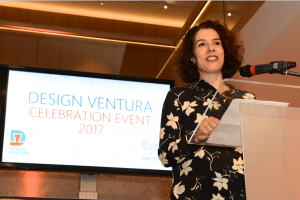
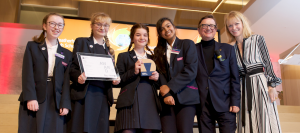
The Design Ventura display with prototypes from all the ten shortlisted schools on the first floor of the Design Museum was also unveiled. This year, the Design Ventura project had 328 schools and over 14,500 students participating. The display is going to be up until the end of March and it is free to visit.
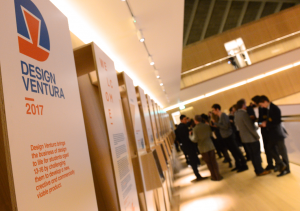
The Celebration Event was really about celebrating design and congratulating all those involved in the Design Ventura. Thank you to everyone who participated in the Design Ventura project making it such a successful project!
All photos ©Richard Heald Photography/Design Museum
-
DV Summit: Kickstarter – The role of the designer is changing
The Design Ventura summit “Design: the problem and the solution” was held on 29 March 2017. Its purpose was to bring together educators, designers, cultural providers and policy makers to discuss how they can ensure that young people are developing creativity, design thinking and employability skills to prepare them for future success.
The following extract is by Heather Corcoran, Design & Technology Outreach at Kickstarter, on her take on the issues discussed.
There is a shift happening in the way that products are coming to life. The role of the designer (and design) is changing. Whereas in traditional design practice, a designer worked with a manufacturer who dealt with production, sales and marketing, now designers are becoming their own manufacturers, distributors and marketers – creating something analogous to the independent record label in the music industry. It’s the long tail of design: empowered by the new technologies, designers can build a business by selling small quantities of rare items to many customers, as opposed to the traditional model that requires selling large quantities of a small variety of best-sellers.
What this means for design education and for young people is that ‘design entrepreneurship’ — building a new type of design studio and business — becomes a more accessible route, and another career option. But it also requires expanding what we think are ‘design skills’ to include things like clear communications and storytelling ability, to talk directly to audiences and customers; or project management of logistics like shipping or product certification. The shifting role of design requires a shift in design education, helping to open up exciting new possibilities for young people and their careers.
-
DV Summit: Kickstarter – 21st century Design and Technology teaching
The Design Ventura summit “Design: the problem and the solution” was held on 29 March 2017. Its purpose was to bring together educators, designers, cultural providers and policy makers to discuss how they can ensure that young people are developing creativity, design thinking and employability skills to prepare them for future success.
The following extract is by Jonny Edge, Subject Advisor for Design, Technology and Engineering at OCR, on his take on the issues discussed.
The Design Ventura Summit was a wonderful day with professionals from a variety of design, educational and industry interests all engaged with improving the perceptions of Design and Technology. This was not only for the greater good of design education, but also for the broader values, principles and life skills that it has to offer all learners with wide ranging aspirations not directly aligned to a future in design or manufacturing related industries. It was reassuring to hear a clear and consistent message from a variety of key note speakers about the potential and importance of the subject, from the perspective of research, opportunity and the reality of what good designing can contribute to a rapidly evolving future. As someone involved in developing qualifications, I have confidence that we have qualifications that are aligned to the real world and that offer real opportunity to support what 21st century Design and Technology teaching can and should be.
Accepting that we have lost many battles with Design and Technology education, but that we need to refocus on its unique attributes to offer a clear message to key stakeholders will ensure that we are still able to win the fight. This was a refreshing conclusion! Changing misguided perceptions and obtaining industry, higher education and senior management support within schools to do this is important. But making sure that we are clear ourselves within the whole Design and Technology community what we stand for as a subject must in my mind be the primary consideration.
-
DV Summit – Design: the problem and the solution, and the imperative for 21st century design education
The Design Ventura summit “Design: the problem and the solution” was held on 29 March 2017. Its purpose was to bring together educators, designers, cultural providers and policy makers to discuss how they can ensure that young people are developing creativity, design thinking and employability skills to prepare them for future success.
The following extract is by Sorrel Hershberg, Director at The Saturday Club Trust, on her take on the issues discussed.
We don’t know what the jobs of the future will be; that much is abundantly clear from observation of the rapid technological changes of the last century, accelerating dramatically over the last 10 years.
NESTA’s Creativity vs Robots report struck a positive note for design however: creative people are the least likely to be replaced by machines. For me, this is because they don’t just have subject-specific knowledge and skills – such as drawing, modelling, spatial awareness – but also the qualities that make us more future-proof:
- Communications and persuasion
- Visual and verbal dexterity
- Flexibility and adaptability
- Analytical and critical thinking
- Collaborative problem-solving
And, perhaps most importantly, learning to fail.
One of my main fears about the damage being done to mainstream education is not just to do with the marginalisation of creative subjects (even though this is very serious and has long-term consequences) but more crucially the damage done to how we learn.
As the Saturday Club has branched into Science and Engineering and Writing and Talking we have discovered a worrying common thread among all the young people. Firstly, they all feel stressed by exams. And secondly, they don’t like being wrong, or accepting that there is more than one right answer.
So even in subjects that are high status and compulsory up to age 16 – EBacc subjects such as science and maths – even in these subjects you are not taught to think like a scientist. By this I mean the experimental method where you test a theory, observe what happens and learn from it, especially when the experiment fails, or doesn’t have the expected outcome.
This is how we learn new stuff and move things forward. If we only learn what is known now, without allowing for error or deviation, we can’t progress. We won’t discover things like Post-It notes, which were invented from failure: a glue that wasn’t sticky enough. And we wouldn’t find the Jonny Ives, the Margaret Calverts, the Marie Curies or the Stephen Hawkings.
At the Saturday Club, we hope that by having the opportunity to think like designers and scientists, away from the pressure of exams, young people will learn the qualities that will make them future-proof: resilience, flexibility, persuasion, critical thinking, collaborative problem solving and – how to fail.
-
DV Summit: Kickstarter – Maker Education: Part of the solution?
The Design Ventura summit “Design: the problem and the solution” was held on 29 March 2017. Its purpose was to bring together educators, designers, cultural providers and policy makers to discuss how they can ensure that young people are developing creativity, design thinking and employability skills to prepare them for future success.
The following extract is by Carlos Izsak, The Maker Cart, on his take on the issues discussed.
During the Design Ventura summit we heard how creative and design industries are more and more looking at new candidates with art and tech skills. Dr Windsor from Nesta refers to this as Fused skills and in the education world these are more commonly known as STEAM (Science, Tech, Engineering, Arts & Design, Maths). We also heard some interesting discussions on how inadequate our school system is in preparing young people in these skills, most students that do well in STEM don’t take Arts & Design subjects and vice-versa.
Can the Maker Movement and Maker Education provide some answers to address these challenges? and how can we incorporate innovative technology and practices into our schools and other educational institutions?
It’s been fascinating to observe how during the last 10 years the emergence of makerspaces how people are collaborating using new tools and technologies to learn and create amazing projects and products. And how: Creativity, Critical Thinking, Communication and Cooperation (the 4C’s of 21st Century Skills) are strongly encouraged and nurtured in maker education.
As educators, we need to approach Maker Education as learners, showing by example Resilience and a Growth Mindset. That it is ok to find knowledge when we need it (or just in time) as opposed to the just in case model of traditional education. Often Maker projects are riddled with failures which provide the greatest opportunities for learning. The main thing though is to lower the barriers of entry while maintaining a high ceiling.
Now, more than ever, it’s an incredible exciting time for education, with a plethora of tools, toys and machines, cheaper and easier to use than ever! These new technologies together with more progressive pedagogies allow us to better engage (or sometimes re-engage) children and young people in learning useful 21st Century skills. From 3D printers to microbits or even littleBits as we used during our workshop, people can use design thinking, easily prototype electronic projects, mixed them with with arts and crafts and realize great ideas (and iterate).
So the question should not be one of if we should embrace Maker Education in mainstream education but of how can we incorporate Maker Education in everyday teaching? And how can we (as professionals in the field) support teachers in these mighty task?
-
DV Summit: Kickstarter – Fear & Love
The Design Ventura summit “Design: the problem and the solution” was held on 29 March 2017. Its purpose was to bring together educators, designers, cultural providers and policy makers to discuss how they can ensure that young people are developing creativity, design thinking and employability skills to prepare them for future success.
The following extract is by Anjeli Placzek, from the Concept Lounge, on her take on the issues discussed.
The Concept Lounge hosted sessions for the Design Ventura Summit focusing on the theme of “Design: The Problem and the Solution” in context.
Inspired by the principle of ‘skills fusion’ and the benefits of creativity across all industries we invited delegates to journey through the Design Museum’s immersive Fear & Love exhibition. Participants reflected upon encounters during the show to consider how seemingly invisible yet vital aspects of design support daily experience and contribute towards a sense of self and habitat. Together participants considered how innovative thinking and the role of design affect our understanding and navigation of a complex world.
Delegates delved deeper into the notion of humans as story telling animals and design as a tool that guides and reflects our collective narrative. The benefits of creative thinking and practice were highlighted along with the importance of casting challenges through a fresh lens to achieve unexpected, effective future solutions.
The value of harnessing innovative thinking and problem solving from a young age is something that resonated with all participants. The workshop feed back concluded that ideally along with an integrated ‘skills fusion’ approach across subject matters at school, support outside the curriculum is invaluable to offer young people an opportunity to experience the potential of their own creativity and to contextualize this skill in the outside world.
-
DV Summit: Kickstarter – Design to improve the world
The Design Ventura summit “Design: the problem and the solution” was held on 29 March 2017. Its purpose was to bring together educators, designers, cultural providers and policy makers to discuss how they can ensure that young people are developing creativity, design thinking and employability skills to prepare them for future success.
The following extract is by Martin Chandler, an Education Consultant at The Making Project and his take on the issues discussed.
People in the design world are guided by the belief that their products should exist in the world because they improve the lives of others, whether this is safety on bicycles, creating gender equal action figures or building an instrument that aids people to learn to play music. All these contributions improve the world and there are so many inventive people who, given the opportunity, can add more to the diversity, enjoyment, and survivability if only they had the chance.
We have extensive means of passing information, advertising and helping one another. The Sorrell Foundation has enhanced the education of so many, Kickstarter has enabled inventors to follow a design to manufacture.
The United Kingdom is famous for its acceptance of immigrant talent and infusing that into its culture of dynamic, creative entrepreneurial communities, but the education system that has, over many years, developed this wellbeing has been savaged. The findings from the Nesta research indicate that an attack on Design Education not only affects the creative subjects but the development of the whole of the education system!
Is that really a surprise? When you cut one part so drastically it must affect the whole!
-
Design Museum as a place of learning
The Design Ventura summit “Design: the problem and the solution” was held on 29 March 2017. Its purpose was to bring together educators, designers, cultural providers and policy makers to discuss how they can ensure that young people are developing creativity, design thinking and employability skills to prepare them for future success.
The following extract is by Helen Charman, Director of Learning and Research, Learning at the Design Museum and her take on the issues discussed.
The challenges facing design education today are not insurmountable. They are an example of the constraints that designers work within, creatively and with a problem solving mind set. The new Design Museum is an example of this. A refurbishment of the former Commonwealth Institute, a grade II listed modernist building and design landmark that by the opening of this century was largely defunct, it was also an opportunity in waiting. An opportunity for investment in design education that can be a critical force in the twenty-first century, harnessing the potential of design to tackle the challenges of today’s complex world, addressing the skills and workforce needs for a joined up and industry relevant approach that promotes applied creativity and can navigate the challenges of a post Brexit UK. The museum’s response to the problem of design education posed by the summit is to place learning at the core, physically, by establishing a campus-style learning environment with dedicated provision across a suite of spaces in the Swarovski Foundation Centre of Learning, and programmatically, through positioning the museum as an educational hub that connects learning with real world contexts for design – a core tenet of our response to the Industrial Skills Strategy green paper. Design Ventura, the museum’s flagship programme for secondary schools, is a great example of this approach. Supported by Deutsche Bank, the project connects young people to the professional context and practices of design by teaching enterprise, creative and business skills to enable young people to respond to a live brief. The economic future of the UK lies in its creative industries, the UK’s fastest growing sector. The museum has a serious purpose and role to play in education. It is both a showcase for the world’s most inspirational examples of intelligent design and a place to model design education for the 21st century, helping to create the people the future needs: empathic and collaborative, creative and critical thinkers and doers – because with Brexit now a reality, the future isn’t going to get any less complicated anytime soon.
-
Design Ventura Summit Adventures
The Design Ventura summit “Design: the problem and the solution” was held on 29 March 2017. Its purpose was to bring together educators, designers, cultural providers and policy makers to discuss how they can ensure that young people are developing creativity, design thinking and employability skills to prepare them for future success.
The following extract is by Sarah Campbell, Head of Learning Programmes at the Victoria and Albert Museum and her take on the issues discussed.
Last week, the Design Museum hosted a one-day event as part of their Design Ventura(DV) programme, a ‘design and enterprise challenge for students in years 9, 10 and 11, supported by industry professionals’. The museum invited ‘DV stakeholders’ to participate in a series of talks and workshops exploring the following topic: ‘Design: the problem and the solution (and the imperative for 21C design education)’. It was a fascinating day, not least because a large majority of the audience didn’t work in museums or galleries. The delegates were predominantly teachers and designers, and we talked a lot about how their worlds intersect. The subjects we covered included: improving the relationship between education and industry; access to tech training for teachers; the rising trend of ‘design entrepreneurship’; and the skills that young people need for future employment. For this post, I’ve compiled some of my favourite interesting bits from the day – not an easy task as the whole day was made up of interesting bits – if the Design Ventura Summit had been a chocolate-chip cookie, it would have been made entirely of chocolate.
The Summit was particularly timely too. The day before, the new Chair of Arts Council England, Nick Serota, announced a new commission that will identify how young people benefit from an arts education and strategies for improving current provision. Hopefully, they will build on the myriad of existing reports on the subject, not least ImagiNation: the value of cultural learning, commissioned by the Cultural Learning Alliance and published only a few months ago. The Summit also coincided with the day that the UK Government triggered Article 50, marking the official beginning of divorce proceedings from the European Union. This particular cloud cast quite a long shadow over the event, and the potential negative impact of Brexit on the creative industries was raised a few times. And finally, as I was eating my breakfast earlier that morning and listening to the radio, I heard the news that UK schools are working with ever-diminishing budgets which will result in £3 billion cuts by 2019/20. My first thoughts were with teachers and how grim the work of head teachers will be to balance the books. My second thoughts were, naturally, concerned with museum and gallery education. I suspect school trips will be the first item cut from school budgets (who can blame them?) and this will leave our current model of schools’ provision, focused on site visits, high and dry. It doesn’t matter how great our museum learning programmes are, they ain’t worth much if schools can’t afford to get to us.
With all of these issues swirling around in the background, it was useful to take a design perspective on the confluence of education, policy, and the creative industries. NESTA have been very active in this area and have produced a number of useful reports, including:
- The Fusion Effect (2016): this is NESTA’s take on the STEAM agenda, looking at how the arts and sciences can work together more effectively;
- Creativity Vs Robots (2015): how can anyone resist a title like that? This report looks at the future of jobs and what aspects of work are likely to become automated. A recent Guardian article, ‘Science classes won’t future-proof our children. But dance might’, made reference to PricewaterhouseCooper’s prediction that 30% of British jobs will be lost to automation by the 2030s. Fortunately, artificial intelligence still can’t compete with our human creative capacity, so we’ll remain one step ahead of C3PO for a bit longer.
- Solved! Making the Case for Collaborative Problem-Solving (2017): another title that speaks for itself. ‘Problem-solving’ was definitely one of the day’s key words: it was used as a shorthand definition of design; and it was also name-checked as a 21st century core competency, an attribute valued by employers across a range of industries.
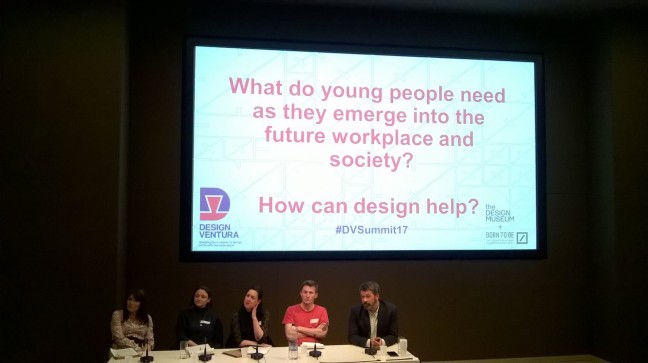
Brexit and the EBacc – a pairing that sounds more like a novelty music act from the 1970s than a confluence of misfortunes – were subjects that couldn’t be avoided. The Government’s Industrial Strategy Green Paper came up in discussion a few times. Published in January, it sets out planning for the UK’s economic future once we have left the EU. Organised around 10 pillars, the ‘developing skills’ priority was considered pertinent to design education and its value to the economy. One speaker also mentioned Brexit Design Manifesto, produced by Dezeen magazine, which is worth a look.
The sharp decline in pupils studying Design and Technology at GCSE level was a particular cause for concern during discussions. The Design and Technology Association (DATA) spearheaded a campaign last year to raise the profile of the subject. Their short film What is Design & Technology – and why do we need it?, made a connection between the investment in D&T in the 1990s and the pay-off over the following decades as those pupils then thrived and built careers in the creative industries. We risk cutting off the pipeline of new talent when design (either through D&T or Art & Design) is cut from a child’s education.
So far, so sadly familiar – the drop in D&T has been a topic of discussion for some time now. What I found more interesting was hearing another perspective on the issue. Holly Donagh from A New Direction framed the EBacc discussion in relation to inclusion agendas. Pupils who graduate with at least five GCSEs will go on to have greater social mobility and more career opportunities than those who don’t. The aim of the EBacc is to get 90% of pupils achieving five GCSEs; whereas the current figure is closer to 35-40%. Living in my leftie echo-chamber, I only ever hear about how awful the EBacc is. Of course it makes sense that those on the other side of the fence also want a high quality education for the next generation – we just have very different views on the role of art and design in achieving that (I should add that Holly was presenting another perspective for the purposes of a group discussion, rather than arguing against design education). Both sides in this debate are deeply entrenched and Holly’s comments made me realise that a greater insight into each other’s rationale would surely help find some middle ground.
And finally, there was plenty of discussion around career pathways for young people. It’s one thing to be at school, and it’s another thing to be established in a career – but getting from A to B is incredibly daunting when you’re 16 and don’t know what you want to do with your life. A huge range of jobs rely on creative skills, and the creative industries are stuffed with a variety of careers, but these opportunities are not well-known. If young people (and their parents) were better informed about what was possible and available, the value of design education would be better understood. The Sorrell Foundation has created the online resource, Creative Journeys, to meet just that purpose. And I should also mention Creative Quarter and Making It are two large careers’ festivals for young people that the V&A’s Learning department run each year.
Another of NESTA’s projects involves sifting through a mountain of online job advertisements to identify the careers that require creative skills. They have sifted through 33 million online ads (promoting UK jobs, dating from 2011-16) and identified 12,000 unique skills. From this data, they have arranged creative skills into five broad categories – Tech, Support, Selling, Creating & Designing, and Teaching. The final resource is still being tested, but it will ultimately provide an online facility whereby a young person can identify their skills and interests and match them to a range of possible career options.
The jobs-market isn’t what it used to be. My own career pathway – from administrator to assistant education officer to education officer to management – feels very old-fashioned when I read the CVs of twenty-somethings, dominated by internships, volunteering, placements and short-term contracts. A patchwork of experience now seems to be the norm. Perhaps not surprisingly, initiative and drive are key attributes in this working climate, and the top buzzword of the day – entrepreneurship – is becoming increasingly important.
Julio Terra from Kickstarter gave one of the keynotes and offered great insights into this new world of work. He recommended designer Craighton Berman and his interest in ‘design entrepreneurship’, championing how designers can work more independently and sustainably. Julio also mentioned ‘D2C’, the designer-to-consumer model, made possible through digital technologies that cut out the middlemen of distribution. And of course Kickstarter itself is changing the game for how new products are backed and launched. I can’t quite believe the company was founded as recently as 2009 – it feels like it’s always been there. In this model, storytelling and narrative have usurped conventional marketing. Young designers are attracting backers through engaging and personal short films to promote their work, made using readily available software.
This brave new world of employment has a rich assortment of pitfalls and opportunities, many of which – for good and bad – are the result of new technologies and a splintered job market. While we need new thinking around education and training to keep abreast of these rapid changes, the path to success remains the same – find something you’re passionate about, word hard, network, and be good at what you do.
Source: https://kiwilooseinmuseums.wordpress.com/2017/04/03/design-ventura-summit-adventures/
-
What do young people need as they emerge into the future workplace?
The Design Ventura summit “Design: the problem and the solution” was held on 29 March 2017. Its purpose was to bring together educators, designers, cultural providers and policy makers to discuss how they can ensure that young people are developing creativity, design thinking and employability skills to prepare them for future success.
The following extract is by Harry Trimble, Designer for Service Manual and Patterns Government Digital Service, on his take on the issues discussed.
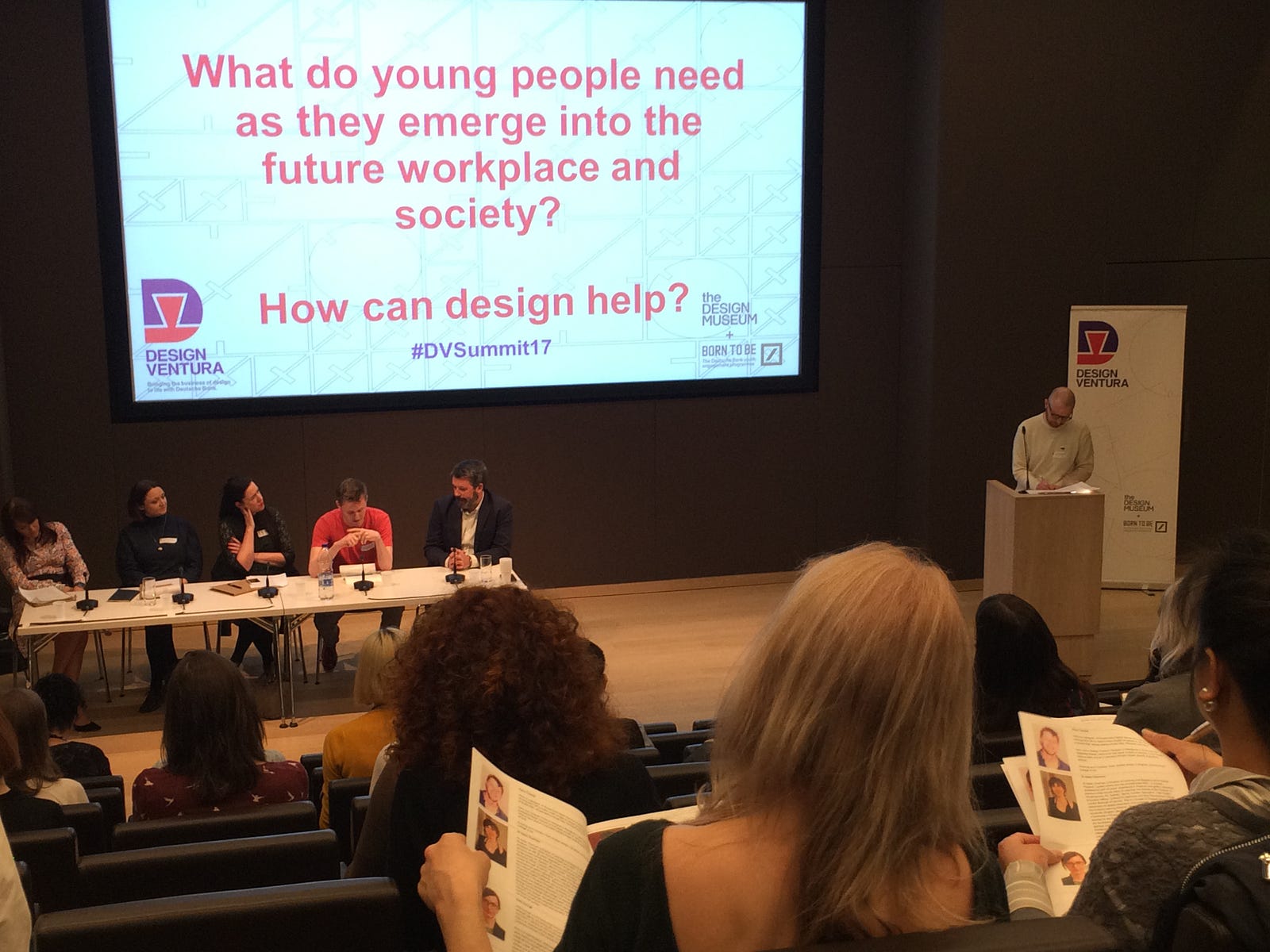
I spoke at the Design Museum on Wednesday, for its design education conference. I was in a panel with some nice people, doing interesting, important things. We spoke for 5 minutes each, then answered some questions.
Here’s what I said:
Hello. I’m Harry. I work on GOV.UK, designing public services.
I only got asked on Friday to come speak here, so apologies if what I’m about to say sounds a little disorganised, raw or even ranty.
Also I’ve framed what I’m about to say in the context of education, rather than about “design”, as that seems a little specific and design is just about problem solving anyhow.
So to answer the question we been given: ‘What do young people need as they emerge into the future workplace, and society? How can design help?’
First we need to focus on learning, not institutions.
From schools to universities to inspectors to workplaces. Institutions are obsessed with themselves and the things they care about. Needless, formal things like testing, exam results, assessment reports and performance reviews. Which are there to make institutions look good. Let’s be honest that doesn’t meet the needs of their users.
Even despite all this measurement, we don’t measure the things that do matter in learning. The outcomes of which can only be observed over years and decades, not weeks and months. For example schools success should measured not by exam results, but how they’re students are doing years after they leave. What jobs they do. Can they adapt to new jobs. How happy they are.
The best learning now is happening on the fringes of institutions. In school code clubs, meet-ups and competitions like Design Ventura. Learning to work in teams, think through making, test ideas and explain your decisions. All things that will help in most careers in the future, not just design. So the more young people who are able and comfortable to do this, the better.
This learning is less formal. It’s more relevant. It’s more agile. It exists to meet young people needs, which institutions are either too slow or unaware to do.
This takes me onto my second point;
Stop teaching people things computers can do. I’ll repeat myself. Stop teaching people things computers can do.
So I don’t mean reading, writing, maths and increasingly coding, which are foundational skills for all learning.
But much of the formal stuff we teach young people are things computer can and will do better: recalling facts and performing standardised processes. We are preparing people for careers that will, if they aren’t already, being automated away. Automated away into history.
Also just as an aside, many of the jobs that are being automated are ones people hate doing anyway.
What we should be doing is teaching young people problem solving, question asking, collaboration, empathy and the ability to learn new things continuously. Things which computers on the whole suck at. Much of our prosperity in the future will be depend on how many people can do jobs computers can’t.
Much of the education systems we have now is still Victorian. As journalist Tom Goodwin said ‘It’s staggering to me as to how much the world has changed, and how little education has.’
We need education for the future. It needs to look like this.
Education will be of the internet, not just on it.
The internet is not about computers, it’s about people.
Education in the future will fully embrace the culture of the internet: it will be more open. More collaborative. More distributed. And more adaptable to change.
This is already happening in some places.
Teachers are collaborating on lesson plans over Facebook. They are meeting on things like Design Ventura’s teacher training, where they can share their enthusiasm about teaching design. This point is the super important: the world can never have enough enthusiastic teachers.
Having networks of enthusiastic design teachers is a powerful thing. Bringing people together around a shared interest is a powerful thing. The internet is great for this.
Another example is Code Club, where thousands of volunteers are teaching kids to code. If you want to set up a Code Club, all you have to do is go online, download the tools and find a room to host it in.
Because it’s a centrally-run resource it can be updated regularly. Meaning the things the children learn is as up-to-date as possible. The internet is great at this too.
Recently at work, we ran a day for degree students interested in design in the public sector. Students came from London, Glasgow, Copenhagen, Berlin and even Buenos Aires. This took nothing more than a blog and Eventbrite to organise.
These examples hint at what education can and needs to be. Hands-on. Project based. Networks of enthusiastic teachers. Open-source curriculums adaptable to change. Backed up by skilled volunteers. Enabled by internet culture and infrastructure.
The world is fast and not short of problems. Education can and should be equal to it.
Thanks.
Source: https://medium.com/@HarryTrimble/design-ventura-summit-241ec7cf5c93



